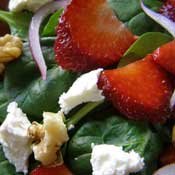Wednesday, August 3, 2011
Much of the food we eat has poor nutritional quality, and many of us value the quantity of our food supply more than its quality. For the sake of convenience and cost, we limit our consumption of whole foods such as fresh fruits and vegetables and turn instead to refined, processed, pre-packaged and pre-made foods.
Farmers grow organic food so that it retains its nutritive value and flavor without unnecessary exposure to potential toxins. To qualify as organic, food is grown or raised in an environment free from chemical fertilizers, pesticides and weed killers, drugs, antibiotics or added hormones.
One of the easiest ways to eat organic food is to frequent local farmers markets, family farms and food co-ops, many of which use organic production methods. Organic options are readily available in health-food stores, supermarkets and even from online distributors. But, while availability is increasing and costs for some foods are coming down, it can still be a challenge to find a good selection in the organic food aisle. This is where you can take advantage of a few square feet of sun-drenched space to grow your own.
Gain ready access to the healthy organic foods your body craves most by growing them yourself. Home gardening can be a great help in avoiding manufactured foods.
For plants, healthy nutrition begins with the most basic elements: sun, water and fertile soil. These elements, a few seeds or seedlings, and a little loving care are all you need to produce nutrient-packed organic foods at home.
First, pick a sunny spot. You can grow a variety of organic foods, such as salad greens and herbs, simply by tending a small patch in the back yard, or a couple of planted pots or boxes on your patio or balcony.
The best soil for organic growing is dark, rich, crumbly topsoil enriched with natural fertilizers, preferably manure or compost. By regularly feeding the soil, you are providing more nutrients for the plants you will eventually eat. Keep the soil, seeds and plants watered, weeded and protected using natural means. This means cultivating, mowing, hand-weeding or covering crops instead of using herbicides for weed control, as well as using natural plant oils, soaps and beneficial bugs to control harmful pests.
Encourage bees, butterflies and other wildlife to visit your garden. They help maintain the natural harmony and balance necessary for organic growing.
Don't be discouraged if you don't grow the world's biggest tomato. Maybe all you can grow at first is a few lettuce leaves for a salad or sandwich or some favorite herbs to spice up your cooking. Enjoy the organic gardening experience and the health benefits it brings: exercise, time spent outdoors in the fresh air and a sense of well-being.
Use your homegrown ingredients to create healthy, tasty meals and snacks. Eat produce fresh and raw, soon after picking. Consider freezing or canning fruits and veggies to preserve their precious nutrients, and use them later in recipes.
Regardless of whether you buy or grow your own organics, the important thing is to find ways to incorporate healthy food choices into your diet. When shopping, consider purchasing 10 percent of your food from the organic section, or aim to prepare and serve one meal a day using as many organic ingredients as possible.
This amazing salad has been a hit with everyone that's ever tried it. In addition to being appealing and colorful, it's easy to make, and the mouth-watering combination of tastes and textures seems to please every appetite.
Crispy Spinach Strawberry Salad
3-ounce package ramen noodles
1 cup walnuts or pecans, chopped
1/4 cup butter
1/4 cup canola oil
2 tablespoons unrefined (raw) sugar
2 tablespoons red wine vinegar
1/2 teaspoon low-sodium soy sauce
8 cups torn organic spinach
1/2 cup chopped organic green onions
2 cups fresh organic strawberries, sliced
1 cup crumbled low-fat feta cheese (optional)
Discard seasoning packet from ramen noodles or save for another use. Break noodles into small pieces. In a skillet, sauté noodles and walnuts or pecans in butter for eight to 10 minutes or until golden; cool.
In a jar with a tight-fitting lid, combine the oil, sugar, vinegar and soy sauce For the dressing; shake well until sugar is completely dissolved.
Just before serving, combine the spinach, onions, strawberries and noodle mixture in a large bowl. Drizzle with dressing and toss gently. Sprinkle crumbled low-fat feta cheese on top of salad (optional).
Serves four.
When shopping, consider purchasing 10 percent of your food from the organic section, or aim to make one meal a day using as many organic ingredients as possible.

Comments
Use the comment form below to begin a discussion about this content.
Sign in to comment
Or login with:
OpenID